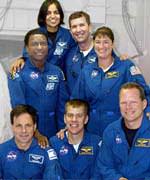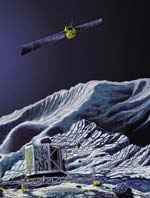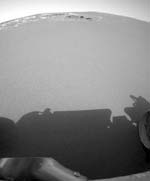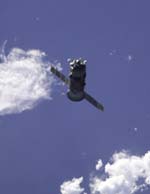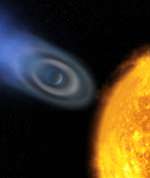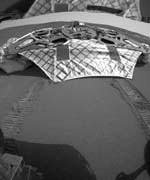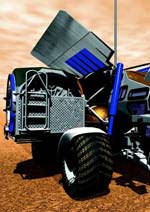
Image credit: James Cameron
As an artist and filmmaker, James Cameron is credited on major Hollywood productions in virtually all roles: writer, director, producer, editor, visual effects, actor, art director, and even crew. Cameron wrote and directed such science fiction classics as “Terminator 2: Judgement Day” (1991), “The Abyss” (1989), and “Aliens” (1986). He received an Academy Award for Best Director for 1997’s “Titanic,” which was also the largest grossing film in history.
Astrobiology Magazine’s Executive Producer, Helen Matsos, sat down with James Cameron and discussed his project slate. During their discussions, Cameron shared how he became interested in Mars and his unique renderings commissioned to represent the key stages in a future human mission to the red planet. As Cameron said about his directorial view: “I think that any kind of exploration should always try to acquire the highest level of imaging. That’s how you engage people — you can put them there, give them the sense that they’re standing there on the surface of Mars.”
The Design Reference Mission (DRM) covers Earth launch to Mars landing, Mars cruise to Mars launch, and Earth return. The mission entails sending cargo ahead, docking the crew at the space station, then meeting up with the cargo supplies once on Mars.
Cameron underscored the need to illustrate the details for each stage of the DRM. And whether deploying a crew or robotic explorers, the mission needed to connect more to a shared human story of discovery. A future Astrobiology Magazine feature will highlight Cameron’s reflections on making such a mission come to life, but this director’s preview offers tantalizing visual cues to what is going on robotically today on Mars.
“The [1997] Sojourner Rover became a character to millions of people, a protagonist in a story. How long is it going to survive, could it perform its mission? It wasn’t anthropomorphic in any way, there was absolutely no emotion in a little solar powered machine that was being commanded from eighty million miles away, and yet people thought of it as a character. The reason we thought of it as a character is that it represented us in a way. It was our consciousness moving that vehicle around on the surface of Mars. It’s our collective consciousness — focused down to that little machine – that put it there. So it was a celebration of who and what we are.”
“It takes our entire collective consciousness and projects it there – to that point in time and space. That’s what the Sojourner Rover did.”
“I was involved in a private company that was going to try to land two rovers on the Moon. That collapsed in the dot com crash – they ran out of money. I’m loosely involved with people who are going to be doing future robotic missions to Mars. I’m involved in terms of imaging, and of how imaging might be improved in terms of story telling. I’ve been very interested in the Humans to Mars movement –the ‘Mars Underground’ — and I’ve done a tremendous amount of personal research for a novel, a miniseries, and a 3-D film.”
“In doing this fictional story about the first humans to Mars — a subject that has been done in the movies, but never done very well, I think — people in the Hollywood community have no idea of what that means. The average person walking around has no idea of what’s involved. I called up NASA and said ‘who’s in charge of Mars?’ It turns out that NASA has (scientists studying Mars) everywhere, but there’s no one person in charge. It’s taken me years to ferret around and talk to everybody.”
In the course of designing this project, we never got past the design stage, although we will eventually. Right now it’s just, ‘what’s everything going to look like?’ What it looked like was determined by how it worked, and how it worked was determined by the mission architecture. ”
“The thing I found about human mission architectures for going to Mars is that if you change one piece or one assumption, it has a ripple effect through the whole thing, and it looks different coming out the other end. You do things differently, your spacecraft are configured differently, your surface mission looks different, the time you spend on the planet looks different. So a certain set of fundamental assumptions had to be made and then we had to design everything for what it was going to look like.”
“I wanted it to be highly realistic. Obviously I don’t think we can predict now, twenty-some years before the fact, exactly how it is going to be done, but we can make a set of very plausible assumptions. We got involved in the design of it, and predicated it on a series of assumptions, and then I went to JSC (Johnson Space Center) to talk to some of the people in the human exploration and development group. I asked, ‘Does this look like what you guys thought?’ They had created overall architectural guidelines in the DRM – the Design Reference Mission – but there were no pictures. Nobody knew what it was really going to look like.”
I said, ‘Look, this is our proposal for what a Hab would look like, and what a pressurized rover would look like, and we made certain assumptions based on how we operate deep submersibles, for example, in terms of how the manipulators would work taking samples and so on.’ And they said, ‘Hey, this is neat! Thanks! If you ever want to get out of filmmaking, come here and hang with us.’
The stages of the Cameron’s Mars Reference Design take a crew and cargo ship from a heavy-lift launch to the flat, red plains of Mars. See the slideshow version.
A Biconic Aeroshell and Fairing is used to transport payloads into space atop a heavy launch vehicle. A single cargo mission will preceed the crew to Mars. The cargo mission provides all the necessary equipment a Mars crew will require to explore the Martian surface for 500 to 600 days.
Included in this cargo are the Cargo Landing Vehicle (CLV), an In Situ Propellant Production Plant Reactor and two inflatable surface Habitats (Hab). This cargo will be placed in the Biconin Aeroshell and will Aerobraking to slow its descent into the martian atmosphere. A heavy-lift launch vehicle will deliver the Crew Transfer Vehicle (CTV) into low Earth orbit (LEO). The CTV will deploy in orbit and rendezvous with the crew at the International Space Station (ISS).
The CTV comprises several systems:an inflatable habitat called the TransHab; the Crew Lander and Rover; and the Aeroshell. The petals of the Aeroshell deploy and lock in place. After cruise, the CTV will tumble end-over-end during Trans-Mars Injection (TMI), creating a 0.38 times earth gravity environment, identical to conditions on Mars. The Crew Lander and Rover, along with their aeroshell will separate from the CTV and enter into the martian atmosphere.
Upon successful aerobraking in the Mars’ atmosphere, the Biconic aeroshell will fall away as large parachutes further assist to slow the CLV in its powered landing. The crew will use steering flaps and reaction control thrusters to guide their entry. During descent, the packed Habs are jettisoned.
The jettisoned Habs will inflate during its independent descent, providing airbag protection to the Cargo Modules housed inside. The aeroshell itself is jettisoned and large parachutes are used to slow the Crew Lander and Rover during descent.
The Crew Lander and Rover will use powerful engines to hover before landing. The Rover’s variable suspension will be capable of absorbing the shock of landing as well as increasing the Rover’s ground clearance. In addition to the Rover’s descent engines, the vehicle will serve as transport and mobile laboratory. A robotic manipulator and crane will allow the crew to interact remotely with the surface. Forward and dorsal docking tunnels simplify crew transfers to the Hab. Power will come from crygenic fuel tanks and a photovoltaic array. The vehicle’s port side includes a centrifugal blower to keep dust to a minimum.
On the surface, the crew must locate both Habs and transport them to the CLV site. The Crew Lander/Rover docks with one of the Habs via the forward hatch. The Mars Mission Base will have a modular design of components that allow for several geometric configurations and expansion.
After landing, the In Situ Propellant Production (ISPP) plant deploys nuclear reactors to power the production of water, oxygen and methane using hydrogen and carbon dioxide as raw materials.
The CLV and ISPP will provide liquid oxygen and methane (LOX/CH4) propellant to the Ascent Crew vehicle. The Ascent Crew vehicle will rendezvous with the Earth Return Vehicle in orbit around Mars.
Original Source: Astrobiology Magazine
